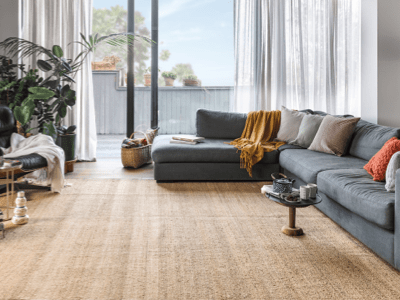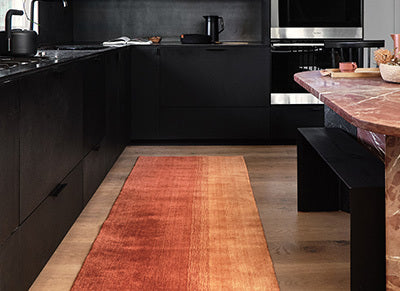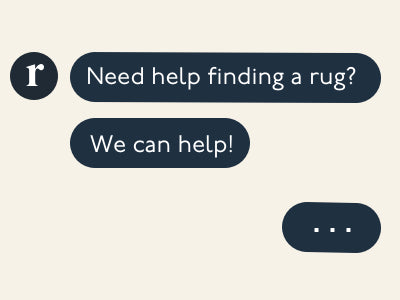














One-of-a-kind new rug, hand-knotted near the small city of Boujad in the Chaouia-Ouardigha region of Morocco
Dimensions: 3'11" x 8'0" (120 cm x 244 cm)
Natural inconsistencies are inherent in these unique, handcrafted rugs
Rug Type:
-
Hand-knotted Rugs
Sturdy pile rugs meticulously woven by hand, with individually hand-tied knots, so no two are exactly alike
Age:
-
New
Recently woven and never used in a home
Main Color:
- Cream
One-of-a-kind new rug, hand-knotted near the small city of Boujad in the Chaouia-Ouardigha region of Morocco
Natural inconsistencies are inherent in these unique, handcrafted rugs
- Only one in stock
- Mixed fiber pile on cotton foundation
- Dimensions: 3'11" x 8'0" (120 cm x 244 cm)
- One-sided fringe: measures 3.9" (10 cm)
- Plush pile: approximately 1.2" (3 cm)
- Color palette: cream, inky black, emerald green, cherry red
- These rugs are prized for their expressive design and construction. Their freeform edges meander and wiggle, unbound by constrictions of mass production
- Moroccan rugs don’t come with a key. As with any painting or poem, their motifs have many subjective interpretations. Originally made for personal use, these rugs took months to weave, documenting a shifting tide of events and emotions in the weaver’s life
- An absolute classic, diamond-based designs create a beautiful and dynamic field of geometric shapes
Boujad was considered a holy town. Boujad rugs were made by a variety of tribes, and thus vary widely in color, composition, and weave. Often described with words like surreal, mystic, and mesmerizing, these rugs depict a world beyond reality. Construction-wise, they have twice as many horizontal as vertical knots, which makes them floppy and easy to move.
Material DetailsThis rug is called a boucherouite, which derives from bu sharwit, a Moroccan Arabic term meaning 'piece of cloth'. Reflective of the ever-shifting post-modern, post-consumer landscape, these 'everything rugs' are woven with colorful miscellaneous fiber scraps. In this piece, a mixed-fiber pile is knotted onto a strong cotton foundation.
- Dust and dirt that accumulate in your rug can erode the fibers over time. The best way to combat this is to take your rug outside and give it a good shake once a week. Depending on how large it is, you may need to recruit a friend to help. Also, be sure to get a rug pad—this helps to preserve your rug in spite of dirt.
- If shaking it out isn’t possible, you can vacuum it instead—just be cautious, and don’t use a rotary vacuum, because it can damage the fibers. Once or twice a month, use the suction attachment gently, from side to side. Once or twice a year, flip your rug over and vacuum the back.
- Once a year, let it sunbathe. Hang it in the sun for a few hours when it’s hottest, and flip it over midway through, to expose both sides to direct sunlight. This sun-bleaching helps further sanitize the wool. It’s a natural method to bleach and deodorize it.
- To ensure equal wear and protect against walk patterns, change your rug's direction periodically. You can also flip your rug upside-down once in awhile, and use it like that for a bit. With Moroccan rugs, the back is typically as nice as the front.
- Every 3-5 years, we recommend getting your rug professionally hand-washed with a Moroccan rug expert. Please do not take it to get steam or dry cleaned—this will almost certainly damage the rug! Hand-washing requires the use of a pH-balanced shampoo, worked into the rug by hand with a soft-bristled brush, before being rinsed thoroughly. This process should be repeated a few times.
- In case of spills:
- If the spill is organic and non-oily (e.g., wine), use a paper towel or cloth to blot the liquid. Add some clean water sparingly to the spot to dilute the stain (or wet a paper towel or cloth) and blot. Repeat this process until the stain is removed.
- If the stain is persistent, resist the urge to scrub. Scrubbing can damage the wool fibers and more easily allow the stain to penetrate. You may try using a mild detergent, such as very diluted dishwashing soap, following the same blot-and-rinse procedure.
- If the spill is a denser, more oily liquid, try first to scoop what you can from the surface using a spoon or perhaps some heavier paper, and then do the blot-and-rinse. If the spill is significant, non-organic and/or composed of chemical substances, or the above methods don’t work, we suggest getting the rug professionally hand-washed as soon as possible.
- For rugs with deeply saturated color palettes, be sure to spot-clean them in an area that can be hosed down immediately after, as some color bleeding may occur.
Order A Sample
Adryan - Rug Sample
Size 12" x 12"
Free shipping & return
Recently Viewed
Adryan Moroccan Rug
Don’t forget to bundle up! Buy 2 or more rugs, get 20% off your rugs.
![]() Free Shipping
Free Shipping
![]() Easy Returns
Easy Returns
One-of-a-kind new rug, hand-knotted near the small city of Boujad in the Chaouia-Ouardigha region of Morocco
Dimensions: 3'11" x 8'0" (120 cm x 244 cm)
Natural inconsistencies are inherent in these unique, handcrafted rugs
One-of-a-kind new rug, hand-knotted near the small city of Boujad in the Chaouia-Ouardigha region of Morocco
Natural inconsistencies are inherent in these unique, handcrafted rugs
- Only one in stock
- Mixed fiber pile on cotton foundation
- Dimensions: 3'11" x 8'0" (120 cm x 244 cm)
- One-sided fringe: measures 3.9" (10 cm)
- Plush pile: approximately 1.2" (3 cm)
- Color palette: cream, inky black, emerald green, cherry red
- These rugs are prized for their expressive design and construction. Their freeform edges meander and wiggle, unbound by constrictions of mass production
- Moroccan rugs don’t come with a key. As with any painting or poem, their motifs have many subjective interpretations. Originally made for personal use, these rugs took months to weave, documenting a shifting tide of events and emotions in the weaver’s life
- An absolute classic, diamond-based designs create a beautiful and dynamic field of geometric shapes
Boujad was considered a holy town. Boujad rugs were made by a variety of tribes, and thus vary widely in color, composition, and weave. Often described with words like surreal, mystic, and mesmerizing, these rugs depict a world beyond reality. Construction-wise, they have twice as many horizontal as vertical knots, which makes them floppy and easy to move.
Material DetailsThis rug is called a boucherouite, which derives from bu sharwit, a Moroccan Arabic term meaning 'piece of cloth'. Reflective of the ever-shifting post-modern, post-consumer landscape, these 'everything rugs' are woven with colorful miscellaneous fiber scraps. In this piece, a mixed-fiber pile is knotted onto a strong cotton foundation.
- Dust and dirt that accumulate in your rug can erode the fibers over time. The best way to combat this is to take your rug outside and give it a good shake once a week. Depending on how large it is, you may need to recruit a friend to help. Also, be sure to get a rug pad—this helps to preserve your rug in spite of dirt.
- If shaking it out isn’t possible, you can vacuum it instead—just be cautious, and don’t use a rotary vacuum, because it can damage the fibers. Once or twice a month, use the suction attachment gently, from side to side. Once or twice a year, flip your rug over and vacuum the back.
- Once a year, let it sunbathe. Hang it in the sun for a few hours when it’s hottest, and flip it over midway through, to expose both sides to direct sunlight. This sun-bleaching helps further sanitize the wool. It’s a natural method to bleach and deodorize it.
- To ensure equal wear and protect against walk patterns, change your rug's direction periodically. You can also flip your rug upside-down once in awhile, and use it like that for a bit. With Moroccan rugs, the back is typically as nice as the front.
- Every 3-5 years, we recommend getting your rug professionally hand-washed with a Moroccan rug expert. Please do not take it to get steam or dry cleaned—this will almost certainly damage the rug! Hand-washing requires the use of a pH-balanced shampoo, worked into the rug by hand with a soft-bristled brush, before being rinsed thoroughly. This process should be repeated a few times.
- In case of spills:
- If the spill is organic and non-oily (e.g., wine), use a paper towel or cloth to blot the liquid. Add some clean water sparingly to the spot to dilute the stain (or wet a paper towel or cloth) and blot. Repeat this process until the stain is removed.
- If the stain is persistent, resist the urge to scrub. Scrubbing can damage the wool fibers and more easily allow the stain to penetrate. You may try using a mild detergent, such as very diluted dishwashing soap, following the same blot-and-rinse procedure.
- If the spill is a denser, more oily liquid, try first to scoop what you can from the surface using a spoon or perhaps some heavier paper, and then do the blot-and-rinse. If the spill is significant, non-organic and/or composed of chemical substances, or the above methods don’t work, we suggest getting the rug professionally hand-washed as soon as possible.
- For rugs with deeply saturated color palettes, be sure to spot-clean them in an area that can be hosed down immediately after, as some color bleeding may occur.






